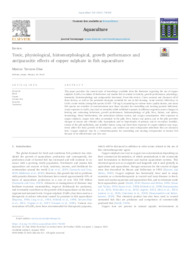Toxic, physiological, histomorphological, growth performance and antiparasitic effects of copper sulphate in fish aquaculture.
Toxic, physiological, histomorphological, growth performance and antiparasitic effects of copper sulphate in fish aquaculture.
Author(s): TAVARES-DIAS, M.
Summary: This paper provides the current state of knowledge available from the literature regarding the use of copper sulphate (CuSO4) in culture of freshwater and marine fish as related to toxicity, growth performance, physiology immunity, histomorphology and antiparasitic treatment. From this review, I have assessed and discussed all of these factors, as well as the potential strategies available for use in fish farming. Acute toxicity (96h-LD50) to CuSO4 varies widely among fish species (0.001?730 mg/L) depending on various water quality factors, and many fish species are sensitive to concentrations near those required for controlling and treating parasite infections. Acute exposure to CuSO4 may lead to mortality while sublethal exposure in different organism causes changes in feeding and swimming behaviour, growth performance, histomorphology of gills, liver, kidney, and spleen, hematology, blood biochemistry, the antioxidant defense system, and oxygen consumption. After exposure to copper sulphate, copper ions often accumulate in the gills, liver, kidney and spleen, and in the gills provokes changes in mucus and chloride cells, hyperplasia and/or hypertrophy of primary and/or secondary lamellae, edema of the gill epithelium, and lamellar fusion. Long and short-term exposure to copper sulphate may negatively affect the body growth of fish exposed, and control and treat ectoparasite infections that are discussed here. Copper sulphate may be a chemotherapeutic for controlling and treating ectoparasites in farmed fish because of its effectiveness and low cost.
Publication year: 2021
Types of publication: Journal article
Unit: Embrapa Amapá
Keywords: Biological treatment, Blood, Copper, Farmed fish, Parasites, Peixe de Água Doce
Observation
Some of Embrapa's publications are published as ePub files. To read them, use or download one of the following free software options to your computer or mobile device. Android: Google Play Books; IOS: iBooks; Windows and Linux: Calibre.
Access other publications
Access the Agricultural Research Database (BDPA) to consult Embrapa's full library collection and records.
Visit Embrapa Bookstore to purchase books and other publications sold by Embrapa.

